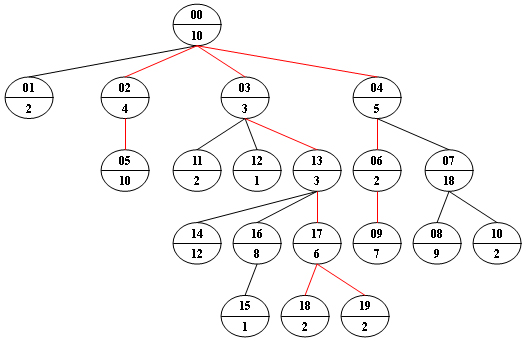Given a non-empty tree with root R, and with weight Wi assigned to each tree node Ti. The weight of a path from R to L is defined to be the sum of the weights of all the nodes along the path from R to any leaf node L.
Now given any weighted tree, you are supposed to find all the paths with their weights equal to a given number. For example, let's consider the tree showed in the following figure: for each node, the upper number is the node ID which is a two-digit number, and the lower number is the weight of that node. Suppose that the given number is 24, then there exists 4 different paths which have the same given weight: {10 5 2 7}, {10 4 10}, {10 3 3 6 2} and {10 3 3 6 2}, which correspond to the red edges in the figure.
Input Specification:
Each input file contains one test case. Each case starts with a line containing 0, the number of nodes in a tree, M (<), the number of non-leaf nodes, and 0, the given weight number. The next line contains N positive numbers where Wi (<) corresponds to the tree node Ti. Then Mlines follow, each in the format:
ID K ID[1] ID[2] ... ID[K]
where ID is a two-digit number representing a given non-leaf node, K is the number of its children, followed by a sequence of two-digit ID's of its children. For the sake of simplicity, let us fix the root ID to be 00.
Output Specification:
For each test case, print all the paths with weight S in non-increasing order. Each path occupies a line with printed weights from the root to the leaf in order. All the numbers must be separated by a space with no extra space at the end of the line.
Note: sequence { is said to be greater than sequence { if there exists 1 such that Ai=Bi for ,, and Ak+1>Bk+1.
Sample Input:
20 9 24
10 2 4 3 5 10 2 18 9 7 2 2 1 3 12 1 8 6 2 2
00 4 01 02 03 04
02 1 05
04 2 06 07
03 3 11 12 13
06 1 09
07 2 08 10
16 1 15
13 3 14 16 17
17 2 18 19
Sample Output:
10 5 2 7
10 4 10
10 3 3 6 2
10 3 3 6 2题意:
给一个树,根为1 ,输出从根到叶子的权值和=m的所有路径(顺序有要求)
题解:
乍一看,就是用vector存储各节点和它的子节点,然后再用个结构体队列bfs一下,后来发现路径是可以找到,但是bfs很难做到题目要求的输出顺序。
所以,改用dfs,但dfs首先要对各节点的子节点按权重从大到小排序,就需要vector内元素排序,以前没用过,sort(v.begin(), v.end(), sortFun)。dfs以一个结构体为单位,存有遍历到的节点编号、权重和和路径p。
但是测试点1一直过不了,有个小坑点,没注意到,就是根节点要特判,可能一个根节点就符合条件了,不需要再遍历了。
AC代码:
#include<iostream> #include<stack> #include<queue> #include<cmath> #include<algorithm> #include<vector> #include<string> #include<cstring> #include<algorithm> using namespace std; int a[105];//每个点的权重 int n,m,w; vector<int>v[105];//存储每个点的字节点编号 struct node{ int key;//当前点编号 int wei;//到当前点的权重和 queue<int>p;//记录路径 }; bool sortFun(const int &p1, const int &p2)//vector内元素排序 { return a[p1] > a[p2];//升序排列 } void dfs(node x){ for(int i=0;i<v[x.key].size();i++){ node y; y.key=v[x.key].at(i); if(x.wei+a[y.key]==w&&v[y.key].size()==0){//必须要保证已经走到底了 queue<int>Q=x.p;//输出 while(!Q.empty()){ cout<<Q.front()<<" "; Q.pop(); } cout<<a[y.key]<<endl; }else if(x.wei+a[y.key]<w){//新的递归下去 y.wei=x.wei+a[y.key]; y.p=x.p; y.p.push(a[y.key]); dfs(y); } } } int main(){ cin>>n>>m>>w; for(int i=0;i<n;i++) cin>>a[i]; for(int i=1;i<=m;i++){ int x,k; cin>>x>>k; for(int j=1;j<=k;j++){ int y; cin>>y; v[x].push_back(y); } //因为输出的路径权重 要按降序,所以可以在DFS之前:给每一个结点的子节点排序 sort(v[x].begin(), v[x].end(), sortFun); } if(a[0]==w){//坑点:根节点要特判 cout<<a[0]<<endl; }else{ node x; x.key=0; x.wei=a[0]; while(!x.p.empty()) x.p.pop(); x.p.push(a[0]); dfs(x); } return 0; }
